Menus
- Amusement district
- Light and filigree, but by no means fragile
- No tremors, no tingling, no unpleasant vibrations
- The V3 technology
- Clever, but not completely problem-free
- Technical specifications
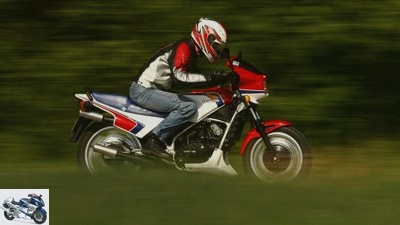
wolf
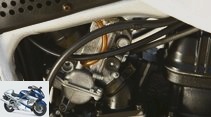

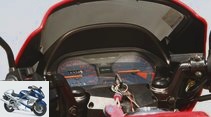
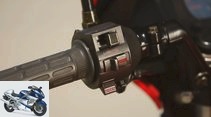
29 photos
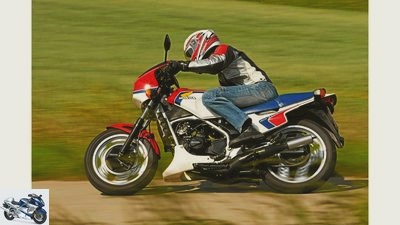
wolf
1/29
The MVX was not a big seller, but the speedster with the V3 engine is still a lot of fun.
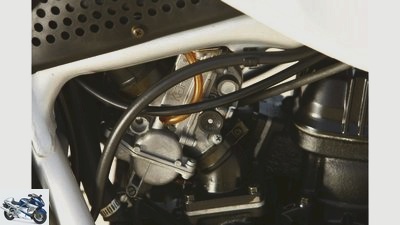
wolf
2/29

wolf
3/29
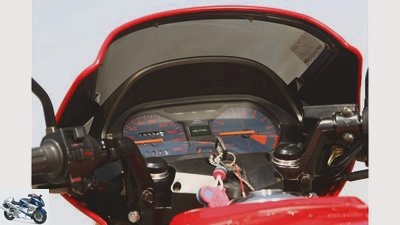
wolf
4/29
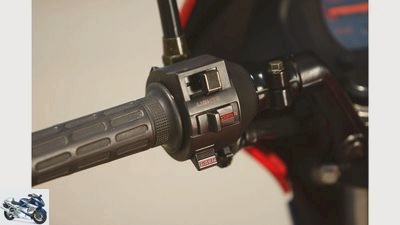
wolf
5/29
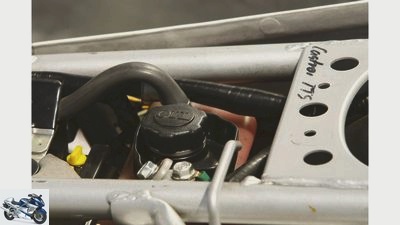
wolf
6/29
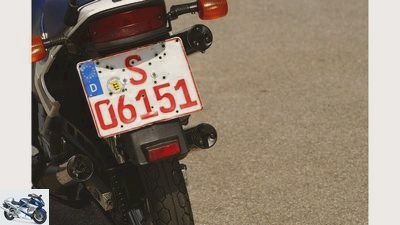
wolf
7/29

wolf
8/29

wolf
9/29
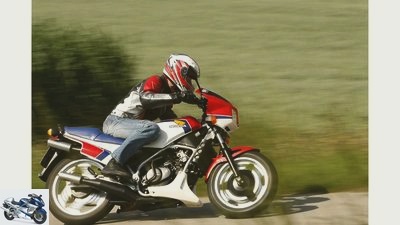
wolf
10/29
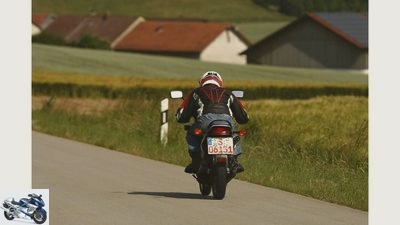
wolf
11/29

wolf
12/29

wolf
13/29
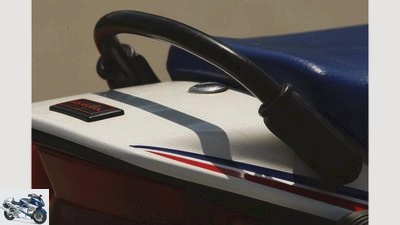
wolf
14/29
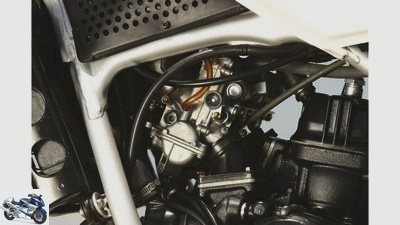
wolf
15/29
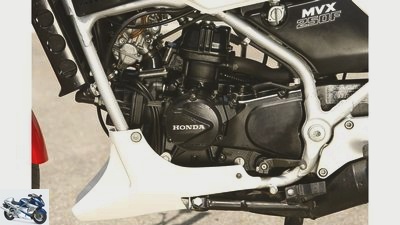
wolf
16/29
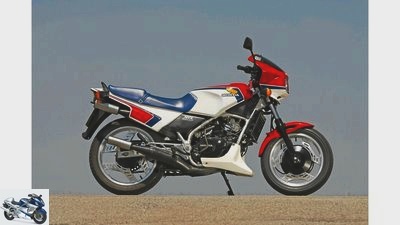
wolf
17/29
With the Honda MVX 250 F you have to feel the two-stroke experience, breathe the scent of the mixture and enjoy the bright sawing sound.

wolf
18/29
Simple, but clear and without any fashionable frills. Sobriety prevails in the cockpit, the speedometer scale is used to the limit by the open 40 hp version.
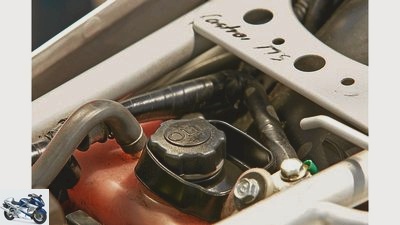
wolf
19/29
The oil tank for the separate lubrication is easily accessible under the seat. At 1.5 liters, however, the supply is not too generous.

wolf
20/29
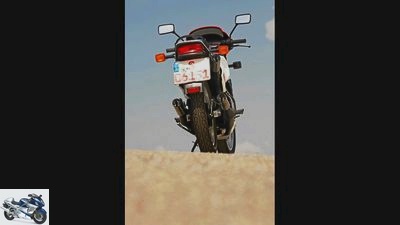
wolf
21/29
It doesn’t always have to be symmetrical – the three exhaust pipes are a mystery to many pursuers.
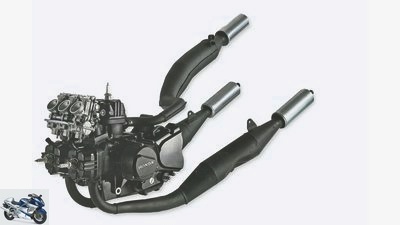
wolf
22/29
One is standing, two are lying – the cylinder arrangement was reversed on the NS 500 factory racer.
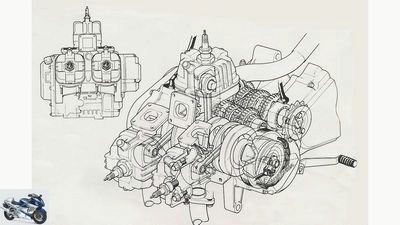
wolf
23/29
The V3 calls for a sophisticated exhaust system.

wolf
24/29
Zeitgeist: The encapsulated disc brake was a fashion phenomenon and disappeared again after a few years.

wolf
25/29
The biting engine tempts you to attack, the aged tires urge you to exercise moderation.
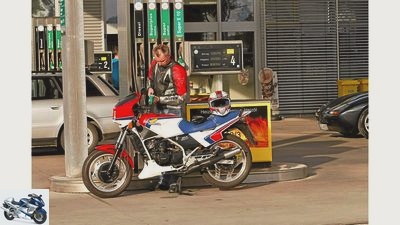
wolf
26/29
Two-stroke drunkards? After all, the MVX 250 F remained under seven liters per 100 kilometers that day.
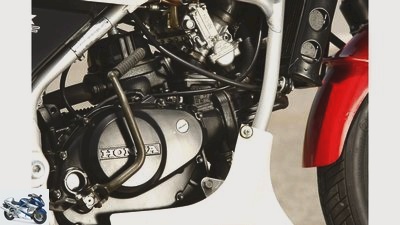
wolf
27/29
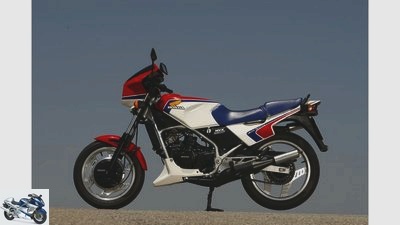
wolf
28/29
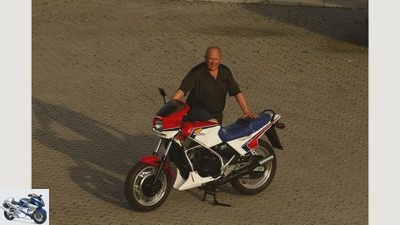
wolf
29/29
On the move with the Honda MVX 250 F.
Amusement district
Content of
The Honda MVX 250 F was not a top seller, but the speedster with the V3 quarter-liter engine is still a lot of fun. MOTORRAD Classic drove them.
D.he 1970s brought us a multitude of today’s coveted, tinny screeching racers – just think of all the GTs, RDs and KHs, even the Germans mixed with Zundapp KS 175 or even Maico MD 250 in the “real” motorcycle league over 125 Cubic with. Only the giant Honda had almost stubbornly devoted itself to the four-stroke engine and only moved very late from the persistent two-stroke refusal.
Buy complete article
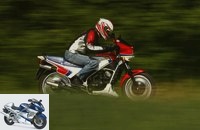
On the move with the Honda MVX 250 F.
Amusement district
Two-stroke V3 with 40 hp
Maybe too late. It was not until 1982 when racing was recognized and the NS 500 with the three-cylinder two-stroke engine launched in the 500 class, with which Freddie Spencer became world champion in 1983, did a rethink in model policy apparently. Anyway, at the beginning of this decade, the Honda managers supported the variety of models, and so there was finally room in the program for a bike with a two-stroke V3, which, however, had little in common with the world championship engine. In view of the 250 cc driving license class, which is popular in Japan, this cubic capacity was also left at that – the engineers conjured up 40 hp from the small triplet, the aim was a rather modest 30,000 units.
wolf
The biting engine tempts you to attack, the aged tires urge you to exercise moderation.
The Honda MVX 250 F, which was primarily intended for the Japanese market, was also offered in Australia and New Zealand, in Europe officially only (of all places) in good Switzerland. From there a few spilled over to Germany, a few gray importers also brought some MVX specimens that they had imported themselves from Japan to the people. Even back then, you could hardly see the 250s on German roads, today it borders on a sensation to see a Honda MVX 250 F jet by live. No wonder that the petite exotic girl, like Fotobike owner Johann Peschke’s, almost always lingers in the garage, here together with his various other youngtimers. All ready to drive at any time, but rarely or not at all moved over the year.
Light and filigree, but by no means fragile
Peschke, now retired, but still on the move with his everyday BMW S 1000 RR, bought the Honda MVX 250 F three years ago, and with just 12,300 kilometers on the clock, the 250 is easy and practical Shine like new. “If the machine is running slowly, it’s warm and it doesn’t turn over,” the man from Lower Bavaria warns before leaving. Sure, after all, you have a heart for the old sweethearts, and there is no world title to be won here, but the two-stroke experience to feel, to breathe the mixed scent and to enjoy the bright sawing sound.
Everything about the Honda MVX 250 F looks light and filigree, but by no means fragile, but solid and neatly processed. Honda has always remained true to this claim, and the same applies to the harmonious ergonomics, which give drivers of almost all sizes that typical “sit on it – fits” feeling. Pull the choke button on the left and prepare the battery for a cold start, consisting of three identical 20 mm Keihin carburettors arranged in a row, unfold the kick starter – a gentle kick is all it takes to make the three-cylinder rattle. You could probably even start the engine with a forceful press of your thumb, it’s that easy and reliable.
Let it warm up a little, let’s go. And that without any speed spectacle, but quite civil, with a clutch that can be easily controlled and sufficient starting power from 2,500 to 3,000 rpm. Fast sprint starts are not popular today. With the feeling of sitting on a comfortable 125cc, the first few bends are taken with the Honda MVX 250 F and put to the test of the small 16-inch front wheel. The turning in is not as wobbly as experienced with other 16-inch chassis, but also not as precisely and neutrally as with the 18-inch racers.
No tremors, no tingling, no unpleasant vibrations
The cultivated running of the V3 immediately appears astonishing – no tremors, no tingling, no unpleasant vibrations occur at any speed. The constructive trick regarding mass balancing has obviously paid off. Incidentally, in favor of the harmonious torque curve, the Honda engineers, as they themselves emphasized, designed the engine to be slightly over-square, i.e. long-stroke, and selected the timing and exhaust design accordingly. With the Honda MVX 250 F, it was possible to dispense with complex exhaust control systems and still achieve a balanced performance characteristic.
The typical and desired two-stroke bite still occurs, albeit not quite as dramatically as with other toxic two-stroke machines. From 5500 rpm the Honda MVX 250 F is noticeably more powerful, the higher the speed, the more jagged the needle clicks in the direction of the red area from 9000 tours. Well, at this point the cat has to get out of the bag – the MVX driven here is a version throttled to 27 hp, which, according to Peschke, still has the throttle plates in the exhaust. The Honda MVX 250 F, which was openly tested in 1983, i.e. with 40 hp, adds a bit more and only waves at 10,500 rpm. A top speed of 163 km / h was measured at that time, quite virgin and hardly driven in properly – there would certainly be more. Honda spoke of almost 180 km / h at the time, which again seems a bit optimistic. But top speed is not the issue with the 250, but the bite of the engine, the low weight and the superb handling.
wolf
Zeitgeist: The encapsulated disc brake was a fashion phenomenon and disappeared again after a few years.
The tires mounted on the Comstar wheels, which were popular at Honda at the time, are only 100 or 110 millimeters wide, which makes bending the 160 kilogram Honda child’s play when fully fueled. The double loop frame borrowed from the four-stroke model VT 250 F (as well as the small cockpit fairing) does not show any nakedness, the front fork and the Pro-Link shock absorber at the rear appear firm, but not uncomfortable. The 35-millimeter fork just stucks away unwillingly over small staccato joints. Doesn’t matter – this hardly detracts from the fun of driving on the small lighter, more likely the encapsulated disc brake, which does not (no longer) seem really snappy and from which you would like a slightly crisper pressure point.
The pithy sawing and not at all quiet two-stroke engine makes up for it with the finest Grand Prix sounds when you step through the gears every second in the precisely shiftable, short-ratio gearbox. The perceived acceleration always surpasses the measurable one – this, too, is what makes the complex, if somewhat fragile, two-stroke engine so attractive. Soon after the start of series production, the connecting rod of the standing cylinder was modified and there were complaints about burned-out pistons. It was said that the V3 was not fully gas-proof, and in the end Honda took the Honda MVX 250 F off the market in 1985. So not all of the few 250s sold have survived, so those still in use today should be cherished and looked after – an exotic chapter of two-stroke history that is worth preserving.
The V3 technology
wolf
One is standing, two are lying – the cylinder arrangement was reversed on the NS 500 factory racer.
Due to the success of the NS 500 in the World Championship, Honda decided on a production bike with a V3 engine. But this is where the similarities end. The V3 of the Honda MVX 250 F has a cylinder angle of 90 instead of 112 degrees, one cylinder is standing, two are lying. Honda names space reasons (battery and exhaust) for this arrangement. Probably only half the story – above all, they wanted to use the frame of the VT 250 F for reasons of cost.
Clever, but not completely problem-free
The engineers placed particular emphasis on smooth running, which is why they worked with a crank pin offset of 360 degrees, i.e. all crank pins rotate in parallel. In order to ensure the necessary mass balancing of the individual, vertical cylinders, the connecting rods were designed to be more massive and heavier, and the piston pins are also thicker with a diameter of 18 compared to 12 millimeters. Clever, but not completely problem-free, as it turned out.
Technical specifications
wolf
The V3 calls for a sophisticated exhaust system.
Engine: Water-cooled three-cylinder two-stroke engine, 90 degree cylinder angle, slot-controlled with diaphragm, bore 47 mm, stroke 48 mm, 249.7 cm³, compression 8: 1, 40 HP at 9000 / min, three 20 mm Keihin carburettors, oil bath clutch, six-speed gearbox , Chain drive
Landing gear: Double-loop tubular frame, air-assisted telescopic fork at the front, Ø 35 mm, central spring strut at the rear (Pro-Link system), encapsulated disc brake at the front, Ø 246 mm, drum brake at the rear, Ø 160 mm, weight with a full tank of 160 kg, tank capacity 17 liters
Tires front 100/90 S 16, rear 110/80 S 18
Top speed: 163 km / h
New price (1983): 6,348 marks
Related articles
-
wolf On the move: Hercules K 125 T The Nurnbergerle Content of At that time the Hercules K 125 T was light home cooking; if not exactly the dream…
-
Sports Photography Driving report Honda RC 211 V The vacation flyer The competition fights hard, “Doctor” Valentino Rossi put the Grand Prix in a holiday…
-
On the move with Suzuki RV 50, RV 75, RV 90, RV 125
wolf 22nd photos wolf 1/22 With new tire sizes 130 / 80-18 at the front and 180 / 80-14 at the rear, the VanVan drives more precisely. wolf 2/22 The RV…
-
fact 12th photos fact 1/12 Top brakes: radially screwed six-piston stoppers, ABS and integral actuation. fact 2/12 Builds compact and very narrow: the…
-
Double test Honda CB 400-Yamaha SR 250
Double test Honda CB 400 / Yamaha SR 250 Look back ahead Reconsideration as a forward strategy is also very much in vogue in the small class. Two…
-
On the move: comparison of the Honda CB 500 Four and Suzuki GT 550
Jahn Comparison test classics On the move: Honda CB 500 Four and Suzuki GT 550 Content of The Honda CB 500 Four and the Suzuki GT 550 share a fate: They…
-
On the move: the Honda VF 500 F II and Yamaha RD 500 LC
fact On the move: Honda VF 500 F II and Yamaha RD 500 LC Extreme athlete Content of At the beginning of 1984, the Honda VF 500 F II and Yamaha RD 500 LC…
-
Driving report, Honda SLR 650 Honda SLR 650 For the first time, Honda developed a motorcycle for Europe in Europe. The result was a naked single cylinder…
-
Technology highlights: Bimota Tesi, Honda NR 750, Norton TT
Jahn Technology highlights: Bimota Tesi, Honda NR 750, Norton TT Techno motorcycle The pace of further development in two-wheelers is getting faster and…
-
Gargolov Final Honda NSR 250 SE Two-stroke in perfection It appeared in late 1993 and was barely noticed outside of Japan. But those who drove motorcycle…